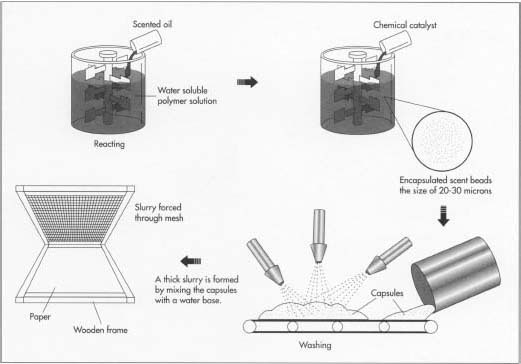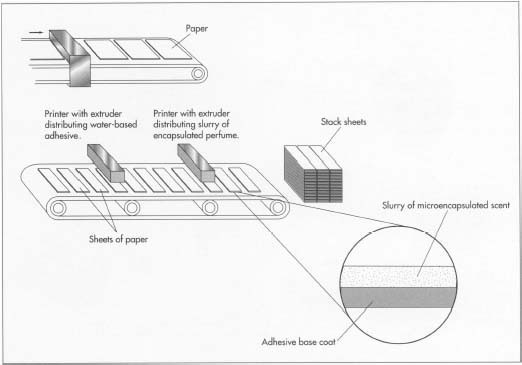Scratch and Sniff
Background
Scratch 'N Sniff™ is the trade name for a special kind of perfume or scent saturated printing in which the scent is enclosed in minute capsules, which can be broken open by friction. Individual beads of scented oil too small to be seen with the naked eye are encapsulated in plastic or gelatin, and with specialized printing techniques, the beads are printed on paper. The scent does not leak out until the beads are deliberately broken. Because scratch and sniff patches keep a scent localized—it can be smelled only when some one deliberately scratches and sniffs—scents can be used in printing without overwhelming the surroundings.
Scratch and sniff is popular in children's books, where the reader can scratch and sniff a picture of a cookie to smell the fresh-baked scent, for example. It is also widely used in advertising, where it may capture the scent of a new car or rubber tire, lumber, burnt match, flowers, the smell of a particular detergent or medicine, mush-rooms, ham, ketchup, butter, mildew, or a host of other scents. Micro-encapsulated scent is most prevalent in perfume advertising. A strip of paper printed with micro-encapsulated perfume oil and tacked shut at the border of the advertisement is generally used instead of the open patch of scratch and sniff. The consumer tears open the strip, thus breaking the capsules in two and releasing the scent.
History
The micro-encapsulation technology that makes scratch and sniff possible was discovered by scientists endeavoring to make carbonless paper. Before the era of the word processor and photocopy machine, typists inserted carbon paper between second and third sheets of white paper to make multiple copies of documents. This could be a messy and aggravating process. In the early 1960s, an organic chemist, Gale Matson, working for 3M (Minnesota Mining and Manufacturing Company) patented a micro-encapsulation process that could be used to make ink copies without carbon paper. The Matson process used a particular plastic called polyoxymethylene urea (PMU). A researcher at National Cash Register came up with a similar micro-encapsulation process using gelatin. Both scientists were thinking only of carbonless paper, but the marketing department at 3M was given the task of finding alternate uses for the technology Matson had patented. It soon became clear that micro-encapsulation could be used for scented oil, and Scratch 'N SniffrM debuted in 1965. The pull-apart perfume strip was introduced in 1981, and has since become the prevalent form of sampling new perfume.
Raw Materials
The basic ingredients of scratch and sniff or perfumed strips are water, oil, scent, and either gelatin or a water soluble polymer, usually polyoxymethylene urea. A certain chemical catalyst is used to bring about the reaction. A water-soluble adhesive is needed to affix the material to the paper during printing.
The Manufacturing
Process
Reacting
-
1 The micro-encapsulation process is done in a large vat or kettle
called a reactor. First, scented oil is added to a solution of
water-soluble polymer in the reactor. At this stage, the oil and water do not mix, and are separate like oil and vinegar in a salad dressing. Then, the mixture is blended at high speed by means of a rotary blade. This part of the process is called high shear agitation. As the rotor blade mixes the oil and water, the oil breaks down into very small beads or droplets. After about 12 hours of agitation, the beads reach the size of from 20 to 30 microns. At this size, the individual beads are not visible to the naked eye, and their width is less than the diameter of a human hair.
 First, scented oil is added to a solution of water-soluble polymer in a reactor. Then, the mixture is blended at high speed by means of a rotary blade until the beads of oil are very small. A chemical catalyst is added, and the polymer surrounds each bead of oil, forming a shell. The newly formed capsules are washed once for scratch and sniff, twice for fragrance strips. Micro-encapsulated scents may be applied to paper in different ways. To make scratch and sniff papers, the slurry of capsules and water can be silk-screened.
First, scented oil is added to a solution of water-soluble polymer in a reactor. Then, the mixture is blended at high speed by means of a rotary blade until the beads of oil are very small. A chemical catalyst is added, and the polymer surrounds each bead of oil, forming a shell. The newly formed capsules are washed once for scratch and sniff, twice for fragrance strips. Micro-encapsulated scents may be applied to paper in different ways. To make scratch and sniff papers, the slurry of capsules and water can be silk-screened.
Adding the catalyst
- 2 When the beads have reached the proper size, the agitation is stopped, and a chemical catalyst is added. The catalyst causes the molecular weight of the polymer to increase, and the polymer becomes water insoluble. The polymer then precipitates out of the water and "rains down" on the oil droplets. The precipitate forms a plastic (or gelatin) shell around each individual oil bead. The oil beads have been encapsulated. At this point, the reaction is stopped.
Washing
- 3 The next step is to remove the capsules from the reactor and wash them. The capsules are removed to a belt, which moves them through a spray of water. The scratch and sniff capsules are washed only once, whereas perfume capsules are washed twice.
Making the slurry
- 4 The washed capsules are then loaded into a tank and mixed with a water base. A thick slurry is formed. For scratch and sniff, adhesives are added to the slurry. At this point, the slurry can be applied to paper using a variety of printing processes.
Printing
-
5 There are four basic methods of printing used with the
micro-encapsulated slurry. It can be silk-screened onto paper or applied
to a pattern gluer for web offset printing. Scratch and sniff is often used for stickers, and these are usually produced through a type of printing known as flexo-graphic printing. The strips of fragrance commonly used in advertisements are produced by extrusion. The fragrance is extruded onto paper in a process similar to the way adhesive is extruded onto tape. The extrusion process is complex and requires state-of-the-art printing equipment. Usually presses capable of handling perfume strip printing have advanced computer controls. To produce the fragrance strip, the paper has to be pre-treated with a base coat of special water-based adhesive which is extruded through pumps on the printer. Then, the base coat must be dried in an oven. After drying, the slurry of micro-encapsulated perfume is extruded onto the strip.
 In order to make fragrance strips, precut papers are pretreated with a base coat of special water-based adhesive which is extruded through pumps on the printer. Then, the base coat must be dried in an oven. After drying, the slurry of micro-encapsulated perfume is extruded onto the strip.
In order to make fragrance strips, precut papers are pretreated with a base coat of special water-based adhesive which is extruded through pumps on the printer. Then, the base coat must be dried in an oven. After drying, the slurry of micro-encapsulated perfume is extruded onto the strip.
Quality Control
The micro-capsules are subjected to many laboratory tests to determine their strength and longevity under stressful conditions. They may be frozen or subjected to steam, and then examined under magnification. Finished printing for a customer is also checked to make sure the scent released is the correct scent and the correct strength. In the case of perfumed strips, if the scent is too weak or too strong, the printers may adjust the width of the strip, and the adhesion of the strip may be altered by adding or subtracting adhesive to the base coat.
The Future
The biggest growth in micro-encapsulating technology has been in perfume strips, possibly because of advancing printing capabilities. Fast, large-scale computer-operated printers with specialized extruder heads are necessary for accurate printing of perfume strips. There have been several new developments in perfume strips in the 1990s, such as pressure sensitive labels and strips that open to reveal tiny pearls of perfume powder that can be applied directly to skin. Future advances seem dependent on the coordination of perfumers, printing technology, and micro-encapsulation technology, in order to make commercially viable products.
Where to Learn More
Periodicals
Charbonneau, Jack and Keith Relyea. "The Technology Behind On-Page Fragrance Sampling." Drug and Cosmetic Industry, February 1997, pp. 48-52.
— Angela Woodward
Comment about this article, ask questions, or add new information about this topic: